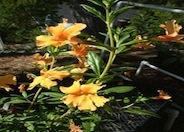
Common name:Sticky Monkey Flower
Botanical name:Mimulus aurantiacus
Sticky Monkey Flower is a drought tolerant evergreen shrub 4 ft. ft tall with numerous orangish/yellow flowers in spring and summer. It is a California native that attracts hummingbirds. This shrub can be found on the dry hills and canyon slopes in the Sierra Nevada foothills and the central Coast Ranges.
-Cornflower Farms
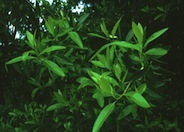
Common name:California Bay, Oregon Myrtle
Botanical name:Umbellularia californica
The California Bay is a aromatic evergreen tree or large shrub that is very slow growing and reaches 30-60 ft. high. It can tolerate sun or shade , moist or dry conditions, and droughts. The California Bay is a native of California & Oregon.

Common name:Sage
Botanical name:Salvia uliginosa
This clumping plant with straight stems of 6-7' and narrow, bright green leaves is a favorite of hummingbirds. These highly aromatic leaves are accented by pale blue and white flowers. The flowers are arranged in long, branched clusters measuring 5" long This plant blooms throughout the entire summer.
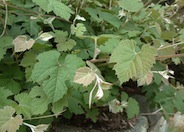
Common name:California Wild Grape
Botanical name:Vitis californica
The California wild grape is a woody deciduous vine that with round large leaves. The flowers are in small fragrant blooms and berry clusters appear in the summer. This vine has sprawling , climbing growth habit. The California wild grape is native to California and is drought tolerant. -Cornflower Farms
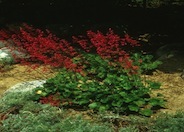
Common name:Coral Bells
Botanical name:Heuchera sanguinea
Tufts of round leaves 2-3" wide with scalloped edges accent this plant. It also produces wiry stems to 24" tall with open clusters of red/pink, bell-shaped flowers.
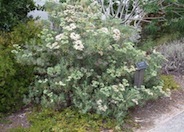
Common name:Santa Cruz Island Buckwheat, Wild B
Botanical name:Eriogonum arborescens
Santa Cruz Island Buckwheat is a loosely branched shrub growing 2-5 ft. high and wide with shredding gray to reddish bark, grayish foliage, and creamy pink spring flowers. It is a California Native, drought tolerant, attracts butterflies and beneficial insects. - Cornflower Farms.
In the natural world the endless cycle of birth, growth, decay, death and rebirth flows throughout the seasons. Plants die, leaves fall and new growth springs up in its place. Nothing is lost and the fallen leaves and dead plants decay into the soil, enriching it for the next generation of growth.
Click in the green box for more information
Designer: Agi Kehoe
Photographer: GardenSoft
Practice grass-cycling by leaving short grass clippings on lawns after mowing, so that nutrients and organic matter are returned to the soil.
Attract, or buy beneficial insects such as ladybugs and lacewings to control pest outbreaks in your garden.